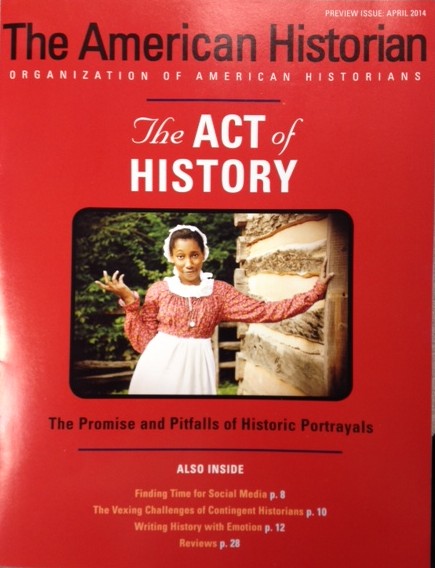I’ve been a member of the Organization of American Historians for roughly the past ten years and for one reason: Magazine of History. The publication has been incredibly helpful to me over the years. Each issue has a clear historical theme and the lesson plans and short essays have direct application to what I do in the classroom. At the beginning of every school year I peruse my back issues for ways to change things up and keep my teaching fresh and challenging. So, you can imagine my surprise and disappointment when I learned that the OAH was discontinuing the magazine for a new publication: The American Historian.
The “preview” issue arrived yesterday and unfortunately it is a bit of a disappointment.
Here is a brief excerpt introducing the magazine from OAH president, Alan Kraut.
In print and online The American Historian is designed to aid, inform, and entertain all of us engaged with the challenges and rewards of bringing the lessons of the American past to others. Where do we do our work? Many of us teach in K-12 classrooms, hoping to take our young students on their first journeys to other to other times and places in their country’s history. Others teach at community colleges or at four-year colleges and universities where our challenge is capturing the past’s complexity and nuance. And still others teach American history outside the academy’s walls–in parks, museums, and on television, computer, and smartphone screens where we reach out to the broader public, hoping to remind them that the past is not past at all, but that American history is neglected at great risk in the construction of the present and the planning for the future.
It’s a laudable goal, but in trying to be all things to all people, I fear that the magazine will have trouble attracting specific segments of the OAH community.
This particular issue focuses “on how important historical figures are portrayed to audiences in a variety of venues, including public history sites, the classrooms, and in mass media.” Heather Cox Richardson briefly explores the ways in which blogging and Twitter can advance both traditional goals of the academy and extend the public reach of professional historians. The challenges of working as adjuncts is discussed by Donald Rodgers. Gary Nash interviews Ian Ruskin, about portraying historical figures on stage and Joanne Pope Melish interviews Azie Dungey about her new video series on portraying slave life at Washington’s Mount Vernon. Finally, Jeff Lantos shares his experience teaching with musicals.
They are all interesting in their own right, but there is really nothing that I can take with me to the classroom. What will this magazine include that will make me a better teacher? I still don’t understand why such a clean break was necessary rather than revising the magazine to include some of these new features.
The larger issue for me in all of this is a sense of belonging. The Magazine of History was the clearest indication that the OAH takes high school history education seriously. I have pretty much no use for The Journal of American History and it’s been a couple of years since I attended one of their conferences. I am left wondering whether I have a reason to maintain my membership.
I should say that this is only the first issue. The editorial staff deserves some time to fine tune their focus. I hope the above comments provides some food for thought.

I miss “The Magazine of History” as well..